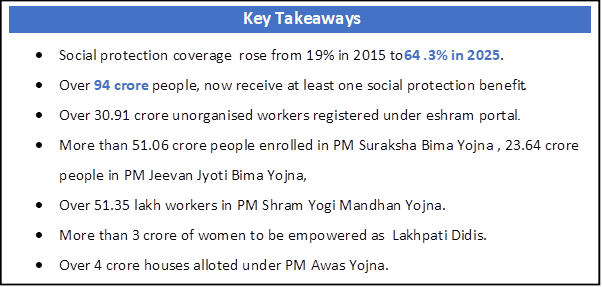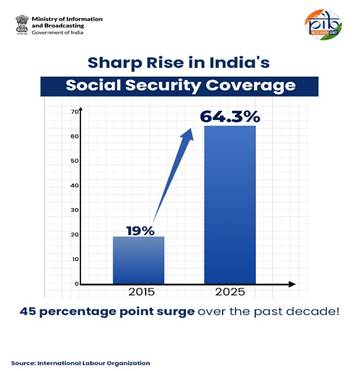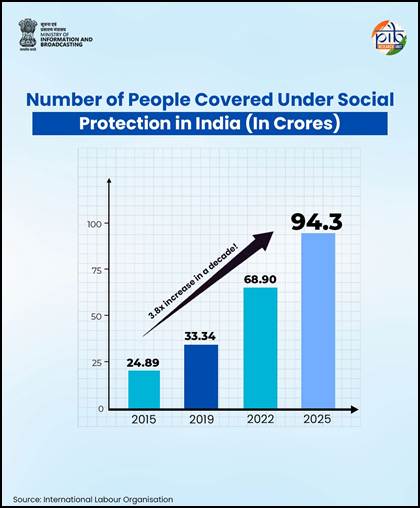Social Welfare
“A quiet revolution : providing a safety net for
94 crore people”
From 19% to 64.3% coverage, over 94 crore people under social security net now
Posted On:
28 JUN 2025 1:12PM

Introduction
India has recorded a phenomenal expansion of social security coverage from 19% in 2015 to 64.3% in 2025. This means that 64.3% of India’s population, i.e. 94.3 crore people, are now covered under at least one social protection benefit. This unprecedented increase has also been acknowledged by International Labour Organization’s (ILO) on its ILOSTAT database. This 45-percentage point jump over ten years marks one of the most significant expansions globally. In terms of number of beneficiaries, India now ranks second in the world after China, in providing social protection to citizens.

Understanding Social Security
As per ILO, social security is the protection that a society provides to individuals and families to ensure access to health care and to guarantee income security. It is especially important in times of old age, sickness, unemployment, disability, maternity, work injury or the loss of a breadwinner. Defined in ILO conventions and UN instruments, social security is recognised as a basic human right.[1]
India has a wide-ranging social security system comprising of social insurance and social assistance schemes both at central and state levels. These include welfare payments, mandatory social insurance with contributions from employer and employee, and other employer-based benefits. In addition to these, there are also schemes providing in kind benefits like food, health, shelter security etc.

The Ministry of Labour and Employment is working closely with ILO for a national social protection data pooling exercise to obtain a holistic picture of social protection coverage in India. Under this project encrypted Aadhaar is being used as a unique identifier across 34 major Central schemes such as MGNREGA, EPFO, ESIC, APY, and PM-POSHAN, to identify unique beneficiaries. Phase I of this pooling exercise started on 19th March 2025 and includes ten states i.e. Uttar Pradesh, Rajasthan, Maharashtra, Madhya Pradesh, Tamil Nadu, Odisha, Andhra Pradesh, Telangana, Karnataka, and Gujarat. This data pooling exercise will not only strengthen India’s global reputation as a social protection pioneer but also facilitate the Central Government, States and UTs to optimize welfare spending and move closer towards sustainable financing of social protection. It will help the States in identifying unique beneficiaries under state-specific social protection schemes.
When assessing the social security coverage of countries, ILO considers only those schemes that are legislatively backed, in cash, and are active, and for which verified time series data of last three years has been provided. The present figure reflects only Phase I of the data pooling exercise. This phase focused on beneficiary data of Central sector schemes and women-centric schemes in selected 8 States.
With Phase II and further consolidation underway, it is expected that India’s total social protection coverage will soon surpass the 100-crore mark upon verification of additional schemes by the ILO. Further, while ILO’s database takes into account only the cash-based schemes, there are millions more who are receiving non-cash coverage through various food and health security schemes.
India is also the first country to update its 2025 social protection data in the ILOSTAT database. This highlights its leadership in digital governance and commitment to building a transparent and inclusive welfare system.
The increase in Social Protection Coverage will strengthen India’s global engagements, particularly in finalising Social Security Agreements (SSAs) with developed nations. These agreements will ensure the portability of social protection benefits for Indian professionals working overseas, while offering partner countries the transparency required for mutual recognition frameworks. This will further bolster India's position in trade and labour mobility negotiations by showcasing a credible and robust social protection regime.
Creating an Enabling Environment for the Expansion
This massive expansion in social security coverage can be seen as a result of the pro-poor and labour welfare schemes undertaken by the Modi Government over the past 11 years, and its focus on creating an inclusive and rights-based social protection ecosystem. The Government has taken several steps to create an environment that enabled such an expansion:
India has more than 50 crore workers, with almost 90 percent in the unorganized sector. The social security ecosystem in the country was riddled with legislations, and there was no social security available to the workers in the unorganized sector. To address these issues, the present government took the initiative to simplify laws and bring the unorganized sector under the ambit of social security protection.
Twenty-nine labour laws have now been codified into 4 Labour Codes –
The Wage Code with amalgamation of 4 laws for ensuring workers’ right to minimum wages
Social Security Code, 2020 with amalgamation of 9 laws to ensure social security protection for all workers including those of unorganized sector
The Occupational Safety, Health and Working Conditions Code with amalgamation of 13 laws(of 2020) to provide right of security to workers in all situations.
Industrial Relations Code with amalgamation of 3 labor laws for safeguarding interests of Trade unions as well as workers.
Social Security Code, 2020; New Labour Code for New India
To ensure security for all workers, the Central Government has amalgamated 9 Labour Laws into the Social Security Code in order to secure the right of workers for insurance, pension, gratuity, maternity benefit etc. The code calls for creation of a comprehensive legal framework for Social Security. Under this, a system would be institutionalized for the contributions received from employer and worker. The Government can fund the contribution of workers from disadvantaged section.
The Code provides for the following benefits to all workers:
- Through a small contribution, benefit of free treatment to be available under hospitals and dispensaries of ESIC.
- ESIC will now be open for the workers of all sectors, along with the workers of the unorganized sector.
- Expansion of ESIC hospitals, dispensaries and branches up to district level. This facility to be increased from 566 districts to all the 740 districts of the country.
- Even if a single worker is engaged in hazardous work, he would be given ESIC benefit.
- Opportunity to join ESIC platform and gig workers engaged in new technology.
- Plantation workers to get benefit of ESIC.
- Institutions working in hazardous area to be compulsorily registered with ESIC.
- Benefit of pension scheme (EPFO) to all workers of organized, unorganized and self-employed sectors.
- Creation of social security fund for providing comprehensive social security to the unorganized sector.
- Requirement of minimum service has been removed for payment of gratuity in case of fixed term employees.
- Employees engaged on fixed term to get same social security benefit as permanent employees.
- Creating a national database of workers of unorganized sector through registration on Portal.
- Employers employing more than 20 workers to mandatorily report vacancies online.
- A Universal Account Number (UAN) for ESIC, EPFO and Unorganised Sector workers.
- Aadhaar based Universal Account Number (UAN) to ensure seamless portability
Building Digital and Financial Foundations
- Jan Dhan Yojana: Financial inclusion has been at the heart of India’s social security push. As of June 18, 2025 over 55.64 crore people hold Jan Dhan accounts, giving them direct access to government benefits and formal banking services.[2]
- Aadhaar and Digital Identity: The Aadhaar programme has helped create a unique digital identity system. As of June 27, 2025, over 142 crore Aadhaar cards have been issued.[3] This system supports authentication and delivery of benefits to the right person at the right time.
- Direct Benefit Transfer (DBT): The DBT system has streamlined welfare payments, reducing leakages and delays. Cumulative savings have reached ₹3.48 lakh crore as of March 2023, reflecting its efficiency and scale.[4]
- Digital Connectivity and 5G Infrastructure: By 2025, 5G services have reached 99.6 percent of the country’s districts. With nearly three lakh base stations added in 2023–24 alone, digital services have become faster and more accessible. The fall in data costs from ₹308 per GB in 2014 to ₹9.34 in 2022 has made digital inclusion affordable for the masses.[5]
Key Government Social Security Programmes
Insurance and Pension Schemes
- Pradhan Mantri Suraksha Bima Yojana (PMSBY): This scheme offers affordable accident insurance and has played a key role in extending basic security to low-income individuals. As of May 2025, it has enrolled 51.06 crore people across the country.
- Pradhan Mantri Jeevan Jyoti Bima Yojana (PMJJBY): A renewable one-year life insurance scheme that offers coverage of ₹2 lakh at a low premium of ₹436 per year. As of May 2025, the scheme covers 23.64 crore individuals.
- Pradhan Mantri Shram Yogi Maandhan Yojana (PM-SYM): This scheme ensures a pension of ₹3,000 per month to unorganised workers after the age of 60. It is voluntary and contributory. As on May 29, 2025, 51.35 lakh workers are enrolled under the scheme.
- Employees' Provident Fund Organisation (EPFO): Formal employment is a key driver of secure income and future savings. In 2024–25 alone, there was a net increase of 1.29 crore people in the EPFO system.[6] April 2025 saw 19.14 lakh new enrolments, underlining continued job growth.[7]
- Employees’ State Insurance Corporation (ESIC): ESIC provides a wide social security net for formal sector workers. It includes medical benefits, cash support during sickness, and unemployment allowance. The scheme continues to be a major pillar of labour welfare in India.
Empowering Women and Households
- Lakhpati Didi Initiative: Aimed at enhancing the income of Self-Help Group women, this programme encourages diverse livelihood options. More than 10 crore women are now part of SHGs. The government has set a goal of empowering 3 crore of them to become Lakhpati Didis.
- PM Ujjwala Yojana: This scheme provides free LPG connections to women from poor households. It has improved health and dignity by promoting clean cooking fuel. Over 10.33 crore connections have been provided as of 2025.
- A Home of One's Own: Housing for All: For many families across rural and urban India, a permanent house was once an unattainable dream. The Pradhan Mantri Awas Yojana (PMAY) changed that narrative. PMAY has two components: Urban and Grameen. A total of nearly 4 crore houses have been completed under PMAY. Under PMAY - Urban, more than 92.72 lakh homes have been delivered, with over 90 lakh houses owned by women.
In rural India, 2.77 crore houses have been completed under PMAY - Grameen. Notably, 60% of these houses have been allocated to SCs and STs, and 25.29% have been registered in the name of women, promoting gender equity.
Securing Informal and Unorganised Workers
- e-Shram Portal: Launched in 2021, the e-Shram portal has registered over 30.91 crore unorganised workers by June 27, 2025.[8] Each worker receives a Universal Account Number to access social security benefits. Notably, 53.77% of the enrollees are women, highlighting inclusive outreach.
- Atal Pension Yojana (APY): APY aims to offer pension support to informal workers. As of December 2024, it has 7.25 crore subscribers and a total corpus of ₹43,370 crore. Complementing it are two insurance schemes, Pradhan Mantri Jeevan Jyoti Bima Yojana and Pradhan Mantri Suraksha Bima Yojana, which offer low-cost life and accident insurance.
- PM Vishwakarma Yojana: The scheme supports traditional artisans and craftsmen through collateral-free loans, toolkits, digital incentives, and marketing help. As of June 9, 2025, 23.7 lakh artisans have registered, and nearly 10 lakh have received toolkit incentives as of 2025.
Expanding Health and Food Security
- Ayushman Bharat: As of June 27, 2025, over 41.29 crore Ayushman Cards have been issued.[9] This scheme provides health insurance of up to ₹5 lakh per family per year and is accepted at more than 32,000 empanelled hospitals across the country. The government, further, launched Ayushman Vay Vandana scheme for extending this coverage to all citizens aged 70 and above, regardless of income. The Ayushman Bharat Digital Mission complements this with over 77 crore Ayushman Bharat Health Accounts, linking citizens to seamless healthcare services.
- Pradhan Mantri Garib Kalyan Anna Yojana (PMGKAY): Launched during the pandemic, this scheme has ensured food security for the vulnerable. As of December 2024, it has reached 80.67 crore people, providing them with free food grains.[10]
Dignity and Protection for Transgenders and Persons with Disabilities
Scheme of Assistance to Persons with Disabilities for Purchase/Fitting of Aids/Appliances (ADIP):
Under the ADIP scheme, funds are released to various implementing agencies for distribution of assistive devices to persons with disabilities to promote their physical, social and psychological rehabilitation and enhancing their economic potential.
Under the scheme, 31.16 lakh persons with disabilities have been provided assistive devices and aids at a cost of Rs. 2415.85 crore during the last 11 years.
The important achievements under the scheme during the last 11 years are as follows:
- 10 Guinness World Records created during the organisation of AIDP camps.
- Since 2014, 18,000+ camps have been conducted, empowering over 31 lakh Divyangjan.
- Divyangjan benefitting from the number of recognised disabilities has been revised from 7 to 21.
Schemes for Transgender Persons:
The Government has launched a scheme SMILE - Support for Marginalized Individuals for Livelihood and Enterprise on February 12, 2022 which includes sub scheme - ‘Comprehensive Rehabilitation for Welfare of Transgender Persons’.
In this regard Ministry of Social Justice and Empowerment has initiated 12 pilot shelter homes namely “Garima Greh : Shelter Home for Transgender Persons”. The main aim of these shelter homes is to provide safe and secure shelter to Transgender persons in need.
Conclusion
India’s journey from 19 percent to 64.3 percent social security coverage in ten years reflects both scale and intent. It shows what is possible when policy, technology and political will work together to serve the people. With over 94 crore individuals now protected under at least one scheme, the country has taken a strong step towards inclusive welfare.
As more schemes are verified and added, this coverage is expected to grow even further. India’s leadership in using digital tools, direct benefit transfers and targeted programmes has set a global example. The momentum built over the past decade must continue, ensuring that every citizen, especially the most vulnerable, remains secure in times of need.
References:
Ministry of Labour & Employment:
International Labour Organisation:
PIB Backgrounders:
Kindly fnd the pdf file.
****
Santosh Kumar/ Abhishek KS/ Saurabh Kalia
(Backgrounder ID: 154784)
Visitor Counter : 5503
Provide suggestions / comments